-
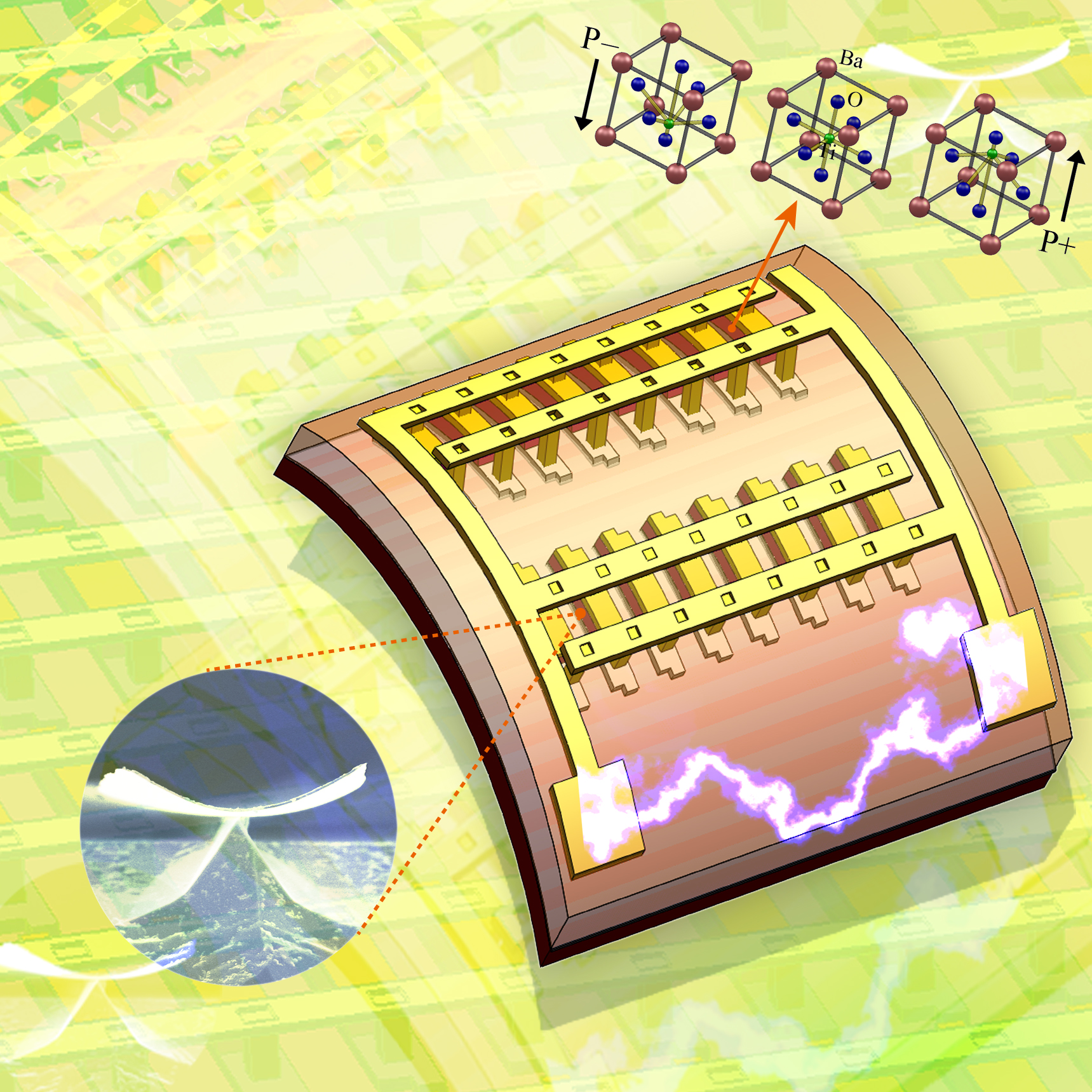 The KAIST & GIT team developed a power generation technology using bendable thin film nano-materials.
Figure description: Flexible thin film nanomaterials produce electricity.
Can a heart implanted micro robot operate permanently?
Can cell phones and tiny robots implanted in the heart operate permanently without having their batteries charged?
It might sound like science fiction, but these things seem to be possible in the near future. The team of Prof. Keon Jae Lee (KAIST, Dept. of Materials Science and Engineering) and Prof. Zhong Lin Wang (Georgia Institute of Technology, Dept. of Materials Science and Engineering) has developed new forms of highly efficient, flexible nanogenerator technology using the freely bendable piezoelectric ceramic thin film nano-materials that can convert tiny movements of the human body (such as heart beats and blood flow) into electrical energy.
The piezoelectric effect refers to voltage generation when pressure or bending strength is applied to piezoelectric materials. The ceramics, containing a perovskite structure, have a high piezoelectric efficiency. Until now, it has been very difficult to use these ceramic materials to fabricate flexible electronic systems due to their brittle property.
The research team, however, has succeeded in developing a bio-eco-friendly ceramic thin film nanogenerator that is freely bendable without breakdown.
Nanogenerator technology, a power generating system without wires or batteries, combines nanotechnology with piezoelectrics that can be used not only in personal mobile electronics but also in bio-implantable sensors or as an energy source for micro robots. Energy sources in nature (wind, vibration, and sound) and biomechanical forces produced by the human body (heart beats, blood flow, and muscle contraction/relaxation) can infinitely produce nonpolluting energy. (Nanogenerator produces electricity by external forces: http://www.youtube.com/watch?v=tvj0SsBqpBw)
Prof. Keon Jae Lee (KAIST) was involved in the first co-invention of “High Performance Flexible Single Crystal Electronics” during his PhD course at the University of Illinois at Urbana-Champaign. This nanogenerator technology, based on the previous invention, utilized the similar protocol of transferring ceramic thin film nano-materials on flexible substrates and produced voltage generation between electrodes.
Prof. Zhong Lin Wang (Georgia Tech, inventor of the nanogenerator) said, “This technology can be used to turn on an LED by slightly modifying circuits and operate touchable flexible displays. In addition, thin film nano-materials (‘barium titanate’) of this research have the property of both high efficiency and lead-free bio compatibility, which can be used in future medical applications.” This result is published in November online issue of ‘Nano Letters’ ACS journal.
<Video>
Youtube link: http://www.youtube.com/watch?v=tvj0SsBqpBw
Thin Film Nanogenerator produces electricity by external forces.
2010.11.23 View 17298
The KAIST & GIT team developed a power generation technology using bendable thin film nano-materials.
Figure description: Flexible thin film nanomaterials produce electricity.
Can a heart implanted micro robot operate permanently?
Can cell phones and tiny robots implanted in the heart operate permanently without having their batteries charged?
It might sound like science fiction, but these things seem to be possible in the near future. The team of Prof. Keon Jae Lee (KAIST, Dept. of Materials Science and Engineering) and Prof. Zhong Lin Wang (Georgia Institute of Technology, Dept. of Materials Science and Engineering) has developed new forms of highly efficient, flexible nanogenerator technology using the freely bendable piezoelectric ceramic thin film nano-materials that can convert tiny movements of the human body (such as heart beats and blood flow) into electrical energy.
The piezoelectric effect refers to voltage generation when pressure or bending strength is applied to piezoelectric materials. The ceramics, containing a perovskite structure, have a high piezoelectric efficiency. Until now, it has been very difficult to use these ceramic materials to fabricate flexible electronic systems due to their brittle property.
The research team, however, has succeeded in developing a bio-eco-friendly ceramic thin film nanogenerator that is freely bendable without breakdown.
Nanogenerator technology, a power generating system without wires or batteries, combines nanotechnology with piezoelectrics that can be used not only in personal mobile electronics but also in bio-implantable sensors or as an energy source for micro robots. Energy sources in nature (wind, vibration, and sound) and biomechanical forces produced by the human body (heart beats, blood flow, and muscle contraction/relaxation) can infinitely produce nonpolluting energy. (Nanogenerator produces electricity by external forces: http://www.youtube.com/watch?v=tvj0SsBqpBw)
Prof. Keon Jae Lee (KAIST) was involved in the first co-invention of “High Performance Flexible Single Crystal Electronics” during his PhD course at the University of Illinois at Urbana-Champaign. This nanogenerator technology, based on the previous invention, utilized the similar protocol of transferring ceramic thin film nano-materials on flexible substrates and produced voltage generation between electrodes.
Prof. Zhong Lin Wang (Georgia Tech, inventor of the nanogenerator) said, “This technology can be used to turn on an LED by slightly modifying circuits and operate touchable flexible displays. In addition, thin film nano-materials (‘barium titanate’) of this research have the property of both high efficiency and lead-free bio compatibility, which can be used in future medical applications.” This result is published in November online issue of ‘Nano Letters’ ACS journal.
<Video>
Youtube link: http://www.youtube.com/watch?v=tvj0SsBqpBw
Thin Film Nanogenerator produces electricity by external forces.
2010.11.23 View 17298 -
 Time: 50 Best Inventions of 2010--KAIST Online Electric Vehicle
Time, a magazine issued on November 22, 2010, has released a list of “50 Best Inventions of 2010” in its special article. KAIST’s Online Electric Vehicle (OLEV) was selected as one of the year’s biggest and coolest breakthroughs in science and technology.
For the article, please click the link: http://www.time.com/time/specials/packages/article/0,28804,2029497_2030622_2029703,00.html
2010.11.12 View 10404
Time: 50 Best Inventions of 2010--KAIST Online Electric Vehicle
Time, a magazine issued on November 22, 2010, has released a list of “50 Best Inventions of 2010” in its special article. KAIST’s Online Electric Vehicle (OLEV) was selected as one of the year’s biggest and coolest breakthroughs in science and technology.
For the article, please click the link: http://www.time.com/time/specials/packages/article/0,28804,2029497_2030622_2029703,00.html
2010.11.12 View 10404 -
 KAIST Student Earns Five Hundred Million Won on Virtual Thumb Idea.
Hwang Sung Jae, a PhD candidate at the Graduate School of Cultural Technology, developed a Virtual Thumb technology that allows multi-touch functions with one hand. Hwang got his idea from limitations of current mobile phones, including the covering of the screen by the use of fingers and the fact that multi-touch functions are hard to perform with one hand holding the mobile phone.
With this technology, one finger gives the same effect of using both fingers to perform a function. Using the Virtual Thumb that appears on a point corresponding to the point of physical touch, movements corresponding to actual touch movements are mimed to allow zooming in/out and various rotation angle based functions.
In addition, in situations where object rotation is unnecessary, many functions are subjectively matched using the change in rotational angle. It allows for various commands are simultaneously executed without activating a separate commanding menu. In the case of the zoom in command at a corner region, the corner can be zoomed in without moving the object to the center of the screen.
The Virtual Thumb technology can be applied as a middleware on touch-based apparatus including TV remote controls, eBook, mobile phones, tablet PCs, navigation systems and educational apparatus.
“I am honored that a small idea that developed during research can be developed into an actual commercialized technology,” said Hwang. “I will become a researcher who will add to the academic and industrial fields through creative research in the future.”
2010.11.05 View 10471
KAIST Student Earns Five Hundred Million Won on Virtual Thumb Idea.
Hwang Sung Jae, a PhD candidate at the Graduate School of Cultural Technology, developed a Virtual Thumb technology that allows multi-touch functions with one hand. Hwang got his idea from limitations of current mobile phones, including the covering of the screen by the use of fingers and the fact that multi-touch functions are hard to perform with one hand holding the mobile phone.
With this technology, one finger gives the same effect of using both fingers to perform a function. Using the Virtual Thumb that appears on a point corresponding to the point of physical touch, movements corresponding to actual touch movements are mimed to allow zooming in/out and various rotation angle based functions.
In addition, in situations where object rotation is unnecessary, many functions are subjectively matched using the change in rotational angle. It allows for various commands are simultaneously executed without activating a separate commanding menu. In the case of the zoom in command at a corner region, the corner can be zoomed in without moving the object to the center of the screen.
The Virtual Thumb technology can be applied as a middleware on touch-based apparatus including TV remote controls, eBook, mobile phones, tablet PCs, navigation systems and educational apparatus.
“I am honored that a small idea that developed during research can be developed into an actual commercialized technology,” said Hwang. “I will become a researcher who will add to the academic and industrial fields through creative research in the future.”
2010.11.05 View 10471 -
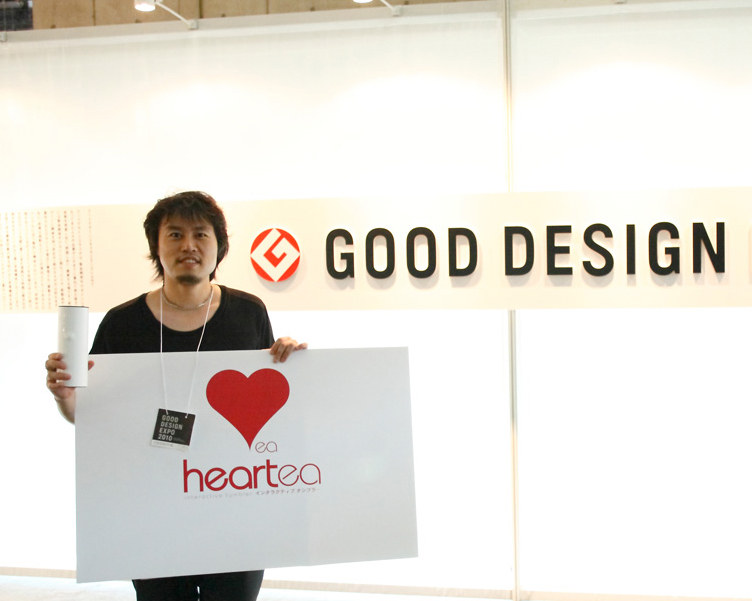 Professor Bae of Industrial Design Wins Good Design Award.
Professor Bae Sang Min’s research team of the Industrial Design Department received a G-Mark on the Product Design Section from the Good Design Awards 2010 organized by the Japan Industrial Design Promotion Organization through the exhibition of a Green Sharing Project, Heartea.
Heartea is a tumbler that allows the user to easily know the temperature of the liquid contained inside. Heartea is a name that combines Heart and Tea to refer to a tumbler that contains heart-warming tea.
Heartea was designed and produced by Professor Bae’s research team and was funded by GS Caltex. World Vision selected charity targets and oversaw distribution, and all of the sales income (about 200 million won) was donated as a scholarship to teenagers with financial difficulties.
The project has begun in 2006, and its accumulative sales are 1.7 billion won. Twenty million won is donated to 147 teenagers every year as scholarship, and through annual sharing camp, social leaders mentor teenagers to help them achieve their dreams.
The Good Design Award organized annually by Japan Industrial Design Promotion Organization has a fifty year tradition and is one of the world’s top four design contests with 6,000 submissions from 50 different countries participated.
Professor Bae’s team has won three of the top four design contests including the German Red Dot Product Award and the American IDEA Product Award.
Along with Heartea, both of foldable MP3 in 2008 and natural humidifier Lovepot in 2009 won an award from these four contests.
“Through continuous research, I hope to create the world’s best philanthropy design research center to help Third World countries and the neglected. I want to participate in creating a better world through design,” said Professor Bae.
2010.11.05 View 13925
Professor Bae of Industrial Design Wins Good Design Award.
Professor Bae Sang Min’s research team of the Industrial Design Department received a G-Mark on the Product Design Section from the Good Design Awards 2010 organized by the Japan Industrial Design Promotion Organization through the exhibition of a Green Sharing Project, Heartea.
Heartea is a tumbler that allows the user to easily know the temperature of the liquid contained inside. Heartea is a name that combines Heart and Tea to refer to a tumbler that contains heart-warming tea.
Heartea was designed and produced by Professor Bae’s research team and was funded by GS Caltex. World Vision selected charity targets and oversaw distribution, and all of the sales income (about 200 million won) was donated as a scholarship to teenagers with financial difficulties.
The project has begun in 2006, and its accumulative sales are 1.7 billion won. Twenty million won is donated to 147 teenagers every year as scholarship, and through annual sharing camp, social leaders mentor teenagers to help them achieve their dreams.
The Good Design Award organized annually by Japan Industrial Design Promotion Organization has a fifty year tradition and is one of the world’s top four design contests with 6,000 submissions from 50 different countries participated.
Professor Bae’s team has won three of the top four design contests including the German Red Dot Product Award and the American IDEA Product Award.
Along with Heartea, both of foldable MP3 in 2008 and natural humidifier Lovepot in 2009 won an award from these four contests.
“Through continuous research, I hope to create the world’s best philanthropy design research center to help Third World countries and the neglected. I want to participate in creating a better world through design,” said Professor Bae.
2010.11.05 View 13925 -
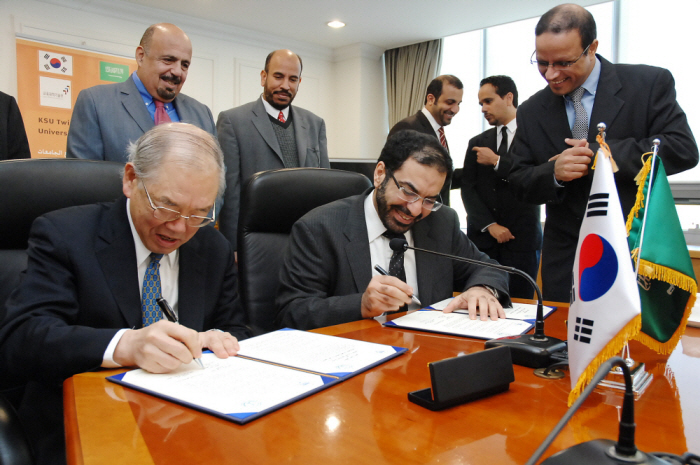 Minister of Higher Education of Saudi Arabia Visited KAIST to Sign Agreement on Joint Research Projects
Khaled bin Mohammad Al-Anqari, the Minister of Higher Education of Saudi Arabia, visited KAIST on October 26th to conclude a joint agreement with KAIST.
The group of Saudi Arabian visitors included Abdullah bin Abdularhman Al-Othman, President of the King Saud University, Osama bin Sadiq Tayeb, President of King Abdulaziz University, and Khalid bin Salih Al-Sultan, President of the best Saudi Arabian technological university, King Fahad University of Petroleum and Minerals.
Through research agreement between KAIST and the King Saud University and King Fahad University of Petroleum and Minerals, joint research projects, mutual visitations of research professors, interchange of academic programs, joint seminars and scientific societies will be held to promote the lively interchange between higher education institutions of Korea and Saudi Arabia.
In particular, King Saud University and KAIST has signed an agreement on joint research projects in the fields of “Solar-Ocean Thermal Exchange Desalination,” “Develop New Energy Management Service for Residential and Commercial Customers Using Smart Metering and Sensor Network Information” and “Superior Production of Lactic Acid from Saudi Dates Using Bioprocess Technology.”
The projects will be funded by the Saudi Arabian government, and their scope will be determined in the future
“Compared to the robust industrial economic interactions between the Middle East and Korea, the interchange of the two countries’ higher education institutions has been poor,” said Jong Hyun Kim, Visiting Professor of Nuclear & Quantum Engineering Department of KAIST who will be conducting one of the joint programs with the Electrical Engineering Department of the King Saud University. “Like this joint research, I hope KAIST will, in many different ways, lead the way in cooperating and interacting with higher education institutions of the Middle EAST.”
Al-Anquari, Minister of Higher Education of Saudi Arabia, who showed great interest in KAIST’s innovative research and high technology development, expressed his will to put more effort into extending the interchange between universities of Saudi Arabia and of Korea, including KAIST.
2010.11.03 View 18017
Minister of Higher Education of Saudi Arabia Visited KAIST to Sign Agreement on Joint Research Projects
Khaled bin Mohammad Al-Anqari, the Minister of Higher Education of Saudi Arabia, visited KAIST on October 26th to conclude a joint agreement with KAIST.
The group of Saudi Arabian visitors included Abdullah bin Abdularhman Al-Othman, President of the King Saud University, Osama bin Sadiq Tayeb, President of King Abdulaziz University, and Khalid bin Salih Al-Sultan, President of the best Saudi Arabian technological university, King Fahad University of Petroleum and Minerals.
Through research agreement between KAIST and the King Saud University and King Fahad University of Petroleum and Minerals, joint research projects, mutual visitations of research professors, interchange of academic programs, joint seminars and scientific societies will be held to promote the lively interchange between higher education institutions of Korea and Saudi Arabia.
In particular, King Saud University and KAIST has signed an agreement on joint research projects in the fields of “Solar-Ocean Thermal Exchange Desalination,” “Develop New Energy Management Service for Residential and Commercial Customers Using Smart Metering and Sensor Network Information” and “Superior Production of Lactic Acid from Saudi Dates Using Bioprocess Technology.”
The projects will be funded by the Saudi Arabian government, and their scope will be determined in the future
“Compared to the robust industrial economic interactions between the Middle East and Korea, the interchange of the two countries’ higher education institutions has been poor,” said Jong Hyun Kim, Visiting Professor of Nuclear & Quantum Engineering Department of KAIST who will be conducting one of the joint programs with the Electrical Engineering Department of the King Saud University. “Like this joint research, I hope KAIST will, in many different ways, lead the way in cooperating and interacting with higher education institutions of the Middle EAST.”
Al-Anquari, Minister of Higher Education of Saudi Arabia, who showed great interest in KAIST’s innovative research and high technology development, expressed his will to put more effort into extending the interchange between universities of Saudi Arabia and of Korea, including KAIST.
2010.11.03 View 18017 -
 2010 International Presidential Forum was held successfully.
On October 11th, the 2010 International Presidential Forum on “The Role of the Research University in an S&T Dominated Era: Expectation & Delivery” was held successfully at the Westin Chosun Hotel in Seoul. The third International Presidential Forum to be held, participants of the 2010 Presidential Forum engaged in an in-depth discussion about the direction that research universities should take in the 21st Century.
On its opening, President Nam Pyo Suh delivered a congratulatory message saying, “This forum is a meaningful gathering where research universities will suggest role models and find ways research universities can contribute to the progress of mankind in this century.”
Following, Lee Ki Jun, CEO of the Korean Federation of Science and Technology Societies said, “The common goal of the world’s research universities is to solve the problems mankind is facing together. I believe that the discussion we will hold today at the forum will point to the future direction of research universities.”
“To produce next generation engineers meeting global standards, exchange and dual degree programs between universities must be strengthened,” said Lars Pallesen, President of the Technical University of Denmark. “Research universities must support the exchange between students beyond cultural and national borders to adapt to the global market.”
Ichiro Okura, Vice President of Tokyo Institute of Technology, presented on the “Asian Science and Technology Pioneering Institutes of Research and Education, ASPIRE.” ASPIRE is a community created by the coalition between science and technology universities in the Far East. Its purpose is to contribute to sustainable global growth by educating high-quality human resources and lead Asia’s technology innovation based on science and technology development.
“For research universities to solve today’s global issues, universities must create new ideas by performing fundamental studies and developing innovative technology. The financial resources of universities must be focused with choices based on results,” remarked President Suh.
Zaini Ujang, Vice-President of the Universiti Teknologi Malaysia stated that “the Malaysian government is planning on converting from a ‘labor-intensive economy’ to an ‘innovative leading economy’ with the goal of joining the advanced countries by 2020. In today’s science and technology era where innovative technology is necessary, research universities have an important role of developing the knowledge environmental system to lead the world economy.” Vice-President Ujang then explained what strategies Malaysian research universities devised in the innovative leading economy era to create research universities that bring creativity and innovation.
Tod A. Laursen, President of KUSTAR, said that “KUSTAR has a leading role in bringing science and technology and manpower necessary in converting the oil-centered economy of UAE to a knowledge-based economy. KUSTAR will continuously strengthen international cooperation to become not only the best engineering university in the Arab region but in the world.”
At this year’s forum, thirty international presidents and vice presidents from 24 universities in 15 countries including Georgia Tech, Technical University of Denmark, Technion-Israel Institute of Technology, University of Queensland, Tokyo University, Nanyang Technological University, University Teknologi Malaysia and Hong Kong Institute of Science and Technology along with forty national figures such as the presidents of Hanyang University and Handong Global University, governmental bureaucrats and representatives from national business and institutions participated.
2010.10.20 View 18766
2010 International Presidential Forum was held successfully.
On October 11th, the 2010 International Presidential Forum on “The Role of the Research University in an S&T Dominated Era: Expectation & Delivery” was held successfully at the Westin Chosun Hotel in Seoul. The third International Presidential Forum to be held, participants of the 2010 Presidential Forum engaged in an in-depth discussion about the direction that research universities should take in the 21st Century.
On its opening, President Nam Pyo Suh delivered a congratulatory message saying, “This forum is a meaningful gathering where research universities will suggest role models and find ways research universities can contribute to the progress of mankind in this century.”
Following, Lee Ki Jun, CEO of the Korean Federation of Science and Technology Societies said, “The common goal of the world’s research universities is to solve the problems mankind is facing together. I believe that the discussion we will hold today at the forum will point to the future direction of research universities.”
“To produce next generation engineers meeting global standards, exchange and dual degree programs between universities must be strengthened,” said Lars Pallesen, President of the Technical University of Denmark. “Research universities must support the exchange between students beyond cultural and national borders to adapt to the global market.”
Ichiro Okura, Vice President of Tokyo Institute of Technology, presented on the “Asian Science and Technology Pioneering Institutes of Research and Education, ASPIRE.” ASPIRE is a community created by the coalition between science and technology universities in the Far East. Its purpose is to contribute to sustainable global growth by educating high-quality human resources and lead Asia’s technology innovation based on science and technology development.
“For research universities to solve today’s global issues, universities must create new ideas by performing fundamental studies and developing innovative technology. The financial resources of universities must be focused with choices based on results,” remarked President Suh.
Zaini Ujang, Vice-President of the Universiti Teknologi Malaysia stated that “the Malaysian government is planning on converting from a ‘labor-intensive economy’ to an ‘innovative leading economy’ with the goal of joining the advanced countries by 2020. In today’s science and technology era where innovative technology is necessary, research universities have an important role of developing the knowledge environmental system to lead the world economy.” Vice-President Ujang then explained what strategies Malaysian research universities devised in the innovative leading economy era to create research universities that bring creativity and innovation.
Tod A. Laursen, President of KUSTAR, said that “KUSTAR has a leading role in bringing science and technology and manpower necessary in converting the oil-centered economy of UAE to a knowledge-based economy. KUSTAR will continuously strengthen international cooperation to become not only the best engineering university in the Arab region but in the world.”
At this year’s forum, thirty international presidents and vice presidents from 24 universities in 15 countries including Georgia Tech, Technical University of Denmark, Technion-Israel Institute of Technology, University of Queensland, Tokyo University, Nanyang Technological University, University Teknologi Malaysia and Hong Kong Institute of Science and Technology along with forty national figures such as the presidents of Hanyang University and Handong Global University, governmental bureaucrats and representatives from national business and institutions participated.
2010.10.20 View 18766 -
 KAIST Animation 'Captain Banana' To Be Shown at SIGGRAPH Asia 2010
‘Captain Banana,’ a short animation created by researchers of Associate Professor Junyong Noh’s Visual Media Laboratory and current students of the Graduate School of Culture Technology (CT), will be shown at SIGGRAPH Asia 2010 this December 15th to 18th.
Following last year’s screening of ‘Taming the Cat’ at the SIGGRAPH CG Animation Festival in the United States, Professor Noh’s work has been chosen to be shown at global CG animation festivals for two years in a row.
Since the first exhibition by ACM in 1974, SIGGRAPH has become a global computer graphic festival that has a strong influence on the global CG and interactive technology industry. The Asian version of SIGGRAPH, SIGGRAPH Asia has been held annually at Singapore in 2008 and Yokohama, Japan in 2009. This year’s SIGGRAPH Asia will be held at COEX in Seoul from December 15th to 18th.
‘Captain Banana’ is a five minute film about Captain Banana, who explains recent issues over sex including unwanted pregnancies, the eradication of abortions and prevention of AIDS through a series of funny situations with his ten little friends.
“Along with being chosen for screening at global CG animation festivals two years in a row, this year’s selection is significant in that the VM Lab has increased the efficiency of the creating process by using technology we have developed on our own,” said Professor Noh.
The production period took approximate five months with approximately 20 current students of CT and five researchers of the Visual Media Lab.
2010.10.20 View 12236
KAIST Animation 'Captain Banana' To Be Shown at SIGGRAPH Asia 2010
‘Captain Banana,’ a short animation created by researchers of Associate Professor Junyong Noh’s Visual Media Laboratory and current students of the Graduate School of Culture Technology (CT), will be shown at SIGGRAPH Asia 2010 this December 15th to 18th.
Following last year’s screening of ‘Taming the Cat’ at the SIGGRAPH CG Animation Festival in the United States, Professor Noh’s work has been chosen to be shown at global CG animation festivals for two years in a row.
Since the first exhibition by ACM in 1974, SIGGRAPH has become a global computer graphic festival that has a strong influence on the global CG and interactive technology industry. The Asian version of SIGGRAPH, SIGGRAPH Asia has been held annually at Singapore in 2008 and Yokohama, Japan in 2009. This year’s SIGGRAPH Asia will be held at COEX in Seoul from December 15th to 18th.
‘Captain Banana’ is a five minute film about Captain Banana, who explains recent issues over sex including unwanted pregnancies, the eradication of abortions and prevention of AIDS through a series of funny situations with his ten little friends.
“Along with being chosen for screening at global CG animation festivals two years in a row, this year’s selection is significant in that the VM Lab has increased the efficiency of the creating process by using technology we have developed on our own,” said Professor Noh.
The production period took approximate five months with approximately 20 current students of CT and five researchers of the Visual Media Lab.
2010.10.20 View 12236 -
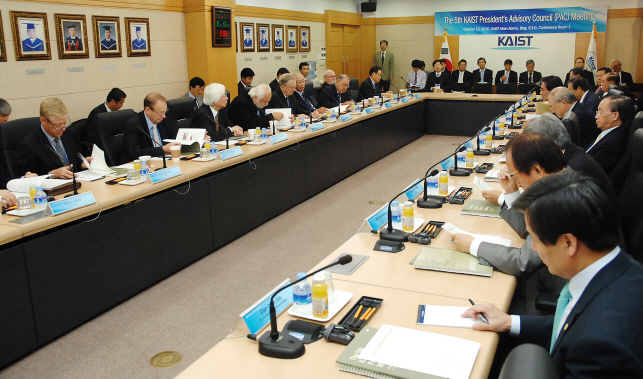 The 5th KAIST President's Advisory Council Held
The 5th KAIST President’s Advisory Council (PAC) was held on October 13 at KAIST. At PAC, President Suh reported important present conditions and achievements of KAIST and introduced the ‘KAIST Vision 2025’ to members of the council which includes top national and international professionals of the Industry-University-Institute collaboration.
Additionally, six latest research assignments of KAIST were selected and presented to the PAC. President Suh also presented the Freshman Design Course, Renaissance Ph.D. Program, KAIST-KUSTAR Cooperation Program, and the visions of Neil Pappalardo Medical Center and received advice from the council.
Through PAC, KAIST receives various strategic advices to develop KAIST into a global science and technology university, direct and indirect support on the KAIST development fund collection, and support to create, maintain and develop cooperation relationships with national and international distinguished institutes linked to advisory council members.
International PAC council members include Donald C. W. Kim, CEO of AMKOR A&E; Neil Pappalardo, former MEDITECH CEO; John R. Holzrichter, President of the Fannie and John Hertz Foundation; Papken Der Torossian, CEO of Vistec Semiconductor Systems Group; Adnan Akay, Vice President of Bilkent University; Arden Bement, Director of the National Science Foundation (NSF); Tod Laursen, President of KUSTAR in the UAE; Lars Pallesen, President of the Technical University of Denmark and Hiroyuki Yoshikawa, former President of the University of Tokyo.
National PAC council members include Kim Woo Sik, President of the Creativity Engineering Institute; Jin Hyun Kim, Chairman of the Committee for the Establishment of the National Museum of Korean Contemporary History; Myung Ja Kim, President of the Green Korea 21 Forum; Lee Hee Gook, President of LG Siltron; Lyu keun Chul, Professor of Bauman Moscow State Technical University; Bo-Young Kang, President of Andong Medical Group; Kwon Oh-Gap, former Vice Minister of Science and Technology; Sang chun Lee, President of Korea Institute of Machinery & Materials; and Bae Soo Hoon, Director of the Museum of Contemporary Art, Korea.
2010.10.20 View 15981
The 5th KAIST President's Advisory Council Held
The 5th KAIST President’s Advisory Council (PAC) was held on October 13 at KAIST. At PAC, President Suh reported important present conditions and achievements of KAIST and introduced the ‘KAIST Vision 2025’ to members of the council which includes top national and international professionals of the Industry-University-Institute collaboration.
Additionally, six latest research assignments of KAIST were selected and presented to the PAC. President Suh also presented the Freshman Design Course, Renaissance Ph.D. Program, KAIST-KUSTAR Cooperation Program, and the visions of Neil Pappalardo Medical Center and received advice from the council.
Through PAC, KAIST receives various strategic advices to develop KAIST into a global science and technology university, direct and indirect support on the KAIST development fund collection, and support to create, maintain and develop cooperation relationships with national and international distinguished institutes linked to advisory council members.
International PAC council members include Donald C. W. Kim, CEO of AMKOR A&E; Neil Pappalardo, former MEDITECH CEO; John R. Holzrichter, President of the Fannie and John Hertz Foundation; Papken Der Torossian, CEO of Vistec Semiconductor Systems Group; Adnan Akay, Vice President of Bilkent University; Arden Bement, Director of the National Science Foundation (NSF); Tod Laursen, President of KUSTAR in the UAE; Lars Pallesen, President of the Technical University of Denmark and Hiroyuki Yoshikawa, former President of the University of Tokyo.
National PAC council members include Kim Woo Sik, President of the Creativity Engineering Institute; Jin Hyun Kim, Chairman of the Committee for the Establishment of the National Museum of Korean Contemporary History; Myung Ja Kim, President of the Green Korea 21 Forum; Lee Hee Gook, President of LG Siltron; Lyu keun Chul, Professor of Bauman Moscow State Technical University; Bo-Young Kang, President of Andong Medical Group; Kwon Oh-Gap, former Vice Minister of Science and Technology; Sang chun Lee, President of Korea Institute of Machinery & Materials; and Bae Soo Hoon, Director of the Museum of Contemporary Art, Korea.
2010.10.20 View 15981 -
 International Workshop on EEWS 2010 was held.
On October 7 and 8th at Fusion Hall of KI Building, KAIST, the 2010 International Workshop on EEWS (Energy, Environment, Water, and Sustainability) was held.
The third to be held, forty national and international academic professionals including Mark Shannon, professor at University of Illinois at Urbana-Champaign, Domen Kazunari, Tokyo University professor, Dong Sub Kim, CTO of SK Energy and Doyoung Seung, Senior Vice President of GS Caltex, participated at this year’s workshop.
In twelve sessions, themes including Artificial Photosynthesis, Wireless Power Transfer, Green Aviation, Safe Nuclear Fuel Reuse, Fuel Cells in Action, LED 2.0, Foundation of Energy-Water Nexus, and Flexible Battery & Solar Cell were presented and discussed.
“Through this workshop, current EEWS policy and research progress from different countries and the future of related technologies will be foreseen,” said Jae Kyu Lee, Dean of KAIST EEWS Initiative. “I hope it became an opportunity to create cooperative relationships with leading researchers.”
EEWS is a research project conducted by KAIST to solve global issues that mankind faces today such as depletion of energy, environmental pollution, water shortage, and sustainability.
2010.10.15 View 19253
International Workshop on EEWS 2010 was held.
On October 7 and 8th at Fusion Hall of KI Building, KAIST, the 2010 International Workshop on EEWS (Energy, Environment, Water, and Sustainability) was held.
The third to be held, forty national and international academic professionals including Mark Shannon, professor at University of Illinois at Urbana-Champaign, Domen Kazunari, Tokyo University professor, Dong Sub Kim, CTO of SK Energy and Doyoung Seung, Senior Vice President of GS Caltex, participated at this year’s workshop.
In twelve sessions, themes including Artificial Photosynthesis, Wireless Power Transfer, Green Aviation, Safe Nuclear Fuel Reuse, Fuel Cells in Action, LED 2.0, Foundation of Energy-Water Nexus, and Flexible Battery & Solar Cell were presented and discussed.
“Through this workshop, current EEWS policy and research progress from different countries and the future of related technologies will be foreseen,” said Jae Kyu Lee, Dean of KAIST EEWS Initiative. “I hope it became an opportunity to create cooperative relationships with leading researchers.”
EEWS is a research project conducted by KAIST to solve global issues that mankind faces today such as depletion of energy, environmental pollution, water shortage, and sustainability.
2010.10.15 View 19253 -
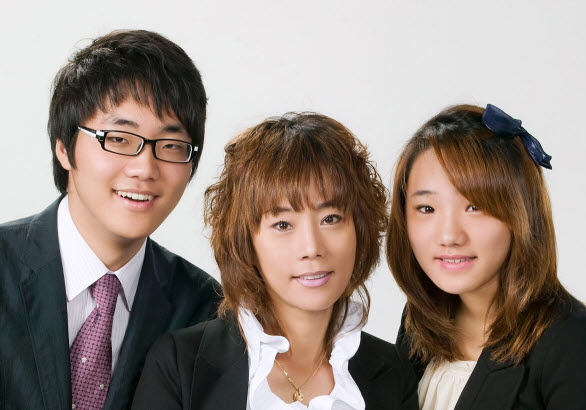 Yoon-Gyeong Shim donates two billion won's worth of stocks to KAIST.
“We hope KAIST will succeed my late husband’s will.”
A 47-year-old widow donated two billion won’s worth of stock to KAIST in respect to her late husband’s will for the scientific development and training of scientifically talented people of Korea.
On the 27 of September, KAIST announced that the late CEO of Seoul Alloy Metal’s widow, Yoon-Gyeong Shim, donated her and her children’s inheritance of two billion won’s worth of stocks to KAIST through an agent.
While wondering how to spend their inherited two billion won, the family found certificates and contracts of donation in the late CEO Geyong-Dae Kim’s possession. The late lamented Mr. Kim had been donating a certain amount of money monthly for those in need, including undernourished children.
Shim decided to donate to Korea’s IT-leading KAIST to succeed her late husband’s will, the husband who lived a life of sharing and dedicated his whole life in the IT department. Shim’s two children, Hyunjae (19 years old) and Youngjae (17 years old) happily participated in this decision.
The company represented by Kim, Seoul Alloy Metals, is a national company that produces basic conjugates used in electric and electronic machinery, with founding technology in the environmental-friendly smokeless lead-free solder division.
“I believe my late husband, who passed away before his time, would be glad with our family’s decision,” said Shim. “We may be living in a faraway country called New Zealand but my children and I are proud Koreans and we are very glad to give a small hand to Korea’s proud KAIST. We hope KAIST can succeed my late husband’s passion and will for the development of scientific technology. We wish it can be used not only for the development of KAIST, but for the development of Korea.”
“KAIST is grateful of Shim’s decision to donate to KAIST,” said President Suh. “To follow the lofty will of the decedent, KAIST will try our best to train the best scientifically talented people and become the best university in the world.”
Since appointment of President Suh at KAIST, KAIST has put an effort to spread a donating culture. As a result, KAIST donators have expanded omnidirectionally, including professors, staff, students, alumni, parents of students, and the general public.
The number of donations was 1,004 in 2006, 2,139 in 2007, 3,066 in 2008, and 3,304 in 2009.
2010.09.29 View 10024
Yoon-Gyeong Shim donates two billion won's worth of stocks to KAIST.
“We hope KAIST will succeed my late husband’s will.”
A 47-year-old widow donated two billion won’s worth of stock to KAIST in respect to her late husband’s will for the scientific development and training of scientifically talented people of Korea.
On the 27 of September, KAIST announced that the late CEO of Seoul Alloy Metal’s widow, Yoon-Gyeong Shim, donated her and her children’s inheritance of two billion won’s worth of stocks to KAIST through an agent.
While wondering how to spend their inherited two billion won, the family found certificates and contracts of donation in the late CEO Geyong-Dae Kim’s possession. The late lamented Mr. Kim had been donating a certain amount of money monthly for those in need, including undernourished children.
Shim decided to donate to Korea’s IT-leading KAIST to succeed her late husband’s will, the husband who lived a life of sharing and dedicated his whole life in the IT department. Shim’s two children, Hyunjae (19 years old) and Youngjae (17 years old) happily participated in this decision.
The company represented by Kim, Seoul Alloy Metals, is a national company that produces basic conjugates used in electric and electronic machinery, with founding technology in the environmental-friendly smokeless lead-free solder division.
“I believe my late husband, who passed away before his time, would be glad with our family’s decision,” said Shim. “We may be living in a faraway country called New Zealand but my children and I are proud Koreans and we are very glad to give a small hand to Korea’s proud KAIST. We hope KAIST can succeed my late husband’s passion and will for the development of scientific technology. We wish it can be used not only for the development of KAIST, but for the development of Korea.”
“KAIST is grateful of Shim’s decision to donate to KAIST,” said President Suh. “To follow the lofty will of the decedent, KAIST will try our best to train the best scientifically talented people and become the best university in the world.”
Since appointment of President Suh at KAIST, KAIST has put an effort to spread a donating culture. As a result, KAIST donators have expanded omnidirectionally, including professors, staff, students, alumni, parents of students, and the general public.
The number of donations was 1,004 in 2006, 2,139 in 2007, 3,066 in 2008, and 3,304 in 2009.
2010.09.29 View 10024 -
 Reasons for Hope: Jane Goodall Lectured at KAIST
Dr. Jane Goodall, globally acknowledged chimpanzee researcher and environmental activist, was invited to KAIST and gave a lecture on the importance of preservation and restoration of the ecosystem on the earth. The lecture took place on the 28 of September at the university’s auditorium from 5PM to 7PM.
The lecture, titled “Reasons for Hope: Celebrating 50 Years of Chimpanzee Research,” was organized to celebrate her longtime career as a primatologist and anthropologist.
The visiting of Dr. Jane Goodall, who had dedicated a long period of time in spreading the significance of the diversity of life, gave a meaningful opportunity to increase the Korean public’s awareness of life’s diversity.
This lecture was jointly sponsored by Ehwa Woman’s University and KAIST, and the lecture was translated by Professor Choi Jae-Chun of Ehwa University.
2010.09.29 View 10641
Reasons for Hope: Jane Goodall Lectured at KAIST
Dr. Jane Goodall, globally acknowledged chimpanzee researcher and environmental activist, was invited to KAIST and gave a lecture on the importance of preservation and restoration of the ecosystem on the earth. The lecture took place on the 28 of September at the university’s auditorium from 5PM to 7PM.
The lecture, titled “Reasons for Hope: Celebrating 50 Years of Chimpanzee Research,” was organized to celebrate her longtime career as a primatologist and anthropologist.
The visiting of Dr. Jane Goodall, who had dedicated a long period of time in spreading the significance of the diversity of life, gave a meaningful opportunity to increase the Korean public’s awareness of life’s diversity.
This lecture was jointly sponsored by Ehwa Woman’s University and KAIST, and the lecture was translated by Professor Choi Jae-Chun of Ehwa University.
2010.09.29 View 10641 -
 KAIST maintains its No. 1 ranking, Joongang Ilbo, Sep. 27, 2010
Joongang Ilbo, one of the leading daily newspapers in Korea, released the results of its annual survey of universities nationwide. KAIST was nominated the best university in the nation for three consecutive years. For the article, please click the link:
http://joongangdaily.joins.com/article/view.asp?aid=2926395
2010.09.27 View 9627
KAIST maintains its No. 1 ranking, Joongang Ilbo, Sep. 27, 2010
Joongang Ilbo, one of the leading daily newspapers in Korea, released the results of its annual survey of universities nationwide. KAIST was nominated the best university in the nation for three consecutive years. For the article, please click the link:
http://joongangdaily.joins.com/article/view.asp?aid=2926395
2010.09.27 View 9627